This article contains content that is written like an advertisement .(April 2024) |
Troy Adams (born 1961) is a real estate developer and interior designer in Los Angeles, California. [1] Adams is also the creator of FusionDesign. [2]
This article contains content that is written like an advertisement .(April 2024) |
Troy Adams (born 1961) is a real estate developer and interior designer in Los Angeles, California. [1] Adams is also the creator of FusionDesign. [2]
Adams was born on October 18, 1961, and grew up in Wasilla, Alaska. He attended Wasilla High School and worked in construction in Alaska before moving to Hawaii. During this 17-year tenure he was commissioned to design a villa in Ubud, Bali where he created the FusionDesign concept.
He has also designed spaces in Guam, Saipan, the Hawaiian Islands, as well as Norway and England. In Germany he learned about German design techniques. He also spent time in Italy learning about Italian kitchen design.
Troy has three sons, and is now based out of Southern California while working on projects both domestically and internationally [3] [4]
Adams is known for a developing interior design concepts, with a focus on concepts which blend European standards of technological minimalist design, American principles of functionality, and qualities of Oriental culture, which he trademarked as FusionDesign. The concept of FusionDesign was implemented in 2000 as a commissioned project for a villa in Ubud, Bali, using natural materials such as basalt, lava stone, bamboo, cork flooring and stainless steel. FusionDesign focuses on open space concepts as well as hidden compartment and hideaway areas to increase both the actual and apparent size of the spaces used. [5]
FusionDesign is a contemporary style built upon respect for nature, inspired by Asian and Pacific Rim cultures. After designing spaces in Guam, Bali and Saipan, Adams created and trademarked the concept. [6]
Another design concept implemented by Adams has been labeled as the "kitchen within a kitchen" concept. This concept is not necessarily new, and was first implemented in the 1960s. The concept entails an 'entertainment kitchen' that faces the main living area, combined with a professional-style kitchen hidden behind closed doors for food preparation and cleanup. This concept is inspired by traditional Japanese kitchen design.
Other design concepts are used by Adams such as integrated fronts and hydraulic lift, kitchen island storage, in order to hide appliances and create a minimalist visual aesthetic while maintaining all the practical functionality of a high end, modern home. [7]
Adams is currently developing his own real estate projects under the Troy Adams Brand.
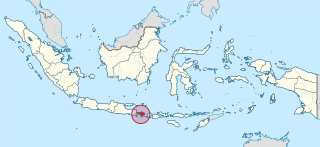
Bali is a province of Indonesia and the westernmost of the Lesser Sunda Islands. East of Java and west of Lombok, the province includes the island of Bali and a few smaller offshore islands, notably Nusa Penida, Nusa Lembongan, and Nusa Ceningan to the southeast. The provincial capital, Denpasar, is the most populous city in the Lesser Sunda Islands and the second-largest, after Makassar, in Eastern Indonesia. Denpasar metropolitan area is the extended metropolitan area around Denpasar. The upland town of Ubud in Greater Denpasar is considered Bali's cultural centre. The province is Indonesia's main tourist destination, with a significant rise in tourism since the 1980s, and becoming an Indonesian area of overtourism. Tourism-related business makes up 80% of the Bali economy.
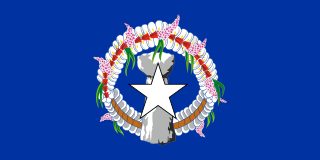
The Northern Mariana Islands, officially the Commonwealth of the Northern Mariana Islands, is an unincorporated territory and commonwealth of the United States consisting of 14 islands in the northwestern Pacific Ocean. The CNMI includes the 14 northernmost islands in the Mariana Archipelago; the southernmost island, Guam, is a separate U.S. territory. The Northern Mariana Islands were listed by the United Nations as a non-self governing territory until 1990.
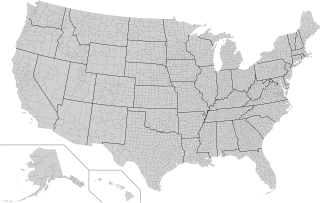
In the United States, a county or county equivalent is an administrative or political subdivision of a U.S. state or other territories of the United States which consists of a geographic area with specific boundaries and usually some level of governmental authority. The term "county" is used in 48 states, while Louisiana and Alaska have functionally equivalent subdivisions called parishes and boroughs, respectively. The specific governmental powers of counties vary widely between the states, with many providing some level of services to civil townships, municipalities, and unincorporated areas. Certain municipalities are in multiple counties; New York City is uniquely partitioned into five counties, referred to at the city government level as boroughs. Some municipalities have been consolidated with their county government to form consolidated city-counties, or have been legally separated from counties altogether to form independent cities. Conversely, counties in Connecticut, Rhode Island, eight of Massachusetts's 14 counties, and Alaska's Unorganized Borough have no government power, existing only as geographic distinctions.

Saipan is the largest island and capital of the Northern Mariana Islands, a Territory of the United States in the western Pacific Ocean. According to 2020 estimates by the United States Census Bureau, the population of Saipan was 43,385. Its people have been United States citizens since the 1980s. Saipan is one of the main homes of the Chamorro, the Indigenous people of the Mariana Islands.

The Mariana Islands, also simply the Marianas, are a crescent-shaped archipelago comprising the summits of fifteen longitudinally oriented, mostly dormant volcanic mountains in the northwestern Pacific Ocean, between the 12th and 21st parallels north and along the 145th meridian east. They lie south-southeast of Japan, west-southwest of Hawaii, north of New Guinea, and east of the Philippines, demarcating the Philippine Sea's eastern limit. They are found in the northern part of the western Oceanic sub-region of Micronesia, and are politically divided into two jurisdictions of the United States: the Commonwealth of the Northern Mariana Islands and, at the southern end of the chain, the territory of Guam. The islands were named after the influential Spanish queen Mariana of Austria following their colonization in the 17th century.

The Chamorro people are the Indigenous people of the Mariana Islands, politically divided between the United States territory of Guam and the encompassing Commonwealth of the Northern Mariana Islands in Micronesia, a commonwealth of the US. Today, significant Chamorro populations also exist in several U.S. states, including Hawaii, California, Washington, Texas, Tennessee, Oregon, and Nevada, all of which together are designated as Pacific Islander Americans according to the U.S. Census. According to the 2000 Census, about 64,590 people of Chamorro ancestry live in Guam and another 19,000 live in the Northern Marianas.

The brown tree snake, also known as the brown catsnake, is an arboreal rear-fanged colubrid snake native to eastern and northern coastal Australia, eastern Indonesia, Papua New Guinea, and many islands in northwestern Melanesia. The snake is slender, in order to facilitate climbing, and can reach up to 2 meters in length. Its coloration may also vary, some being brown, green, or even red. Brown tree snakes prey on many things, ranging from invertebrates to birds, and even some smaller mammals. It is one of the very few colubrids found in Australia, where elapids are more common. Due to an accidental introduction after the events of World War II, this snake is now infamous for being an invasive species responsible for extirpating the majority of the native bird population in Guam. Currently, efforts are being made to reduce and control the population on Guam and prevent the snake from spreading to other locations.

USS Wadleigh (DD-689) was a Fletcher-class destroyer of the United States Navy, named for Rear Admiral George H. Wadleigh (1842–1927).

USS Williamson (DD-244/AVP-15/AVD-2/APD-27) was a Clemson-class destroyer in the United States Navy during World War II. She was named for Commander William Price Williamson.

Disney's Polynesian Village Resort is a Disney-owned and operated resort located at the Walt Disney World Resort. It began operation on October 1, 1971 as one of Walt Disney World Resort's first two on-site hotels. The resort has a South Seas theme, and originally opened with 492 rooms. It was designed by Welton Becket and Associates and constructed by US Steel Realty Development. The resort is owned and operated by Disney Parks, Experiences and Products.

Typhoon Karen was the most powerful tropical cyclone to strike the island of Guam, and has been regarded as one of the most destructive events in the island's history. It was first identified as a tropical disturbance on November 6, 1962, well to the southeast of Truk. Over the following two days, the system tracked generally northward and quickly intensified. Karen became a tropical storm late on November 7, and within two days it explosively intensified into a Category 5-equivalent super typhoon on the Saffir–Simpson scale. Turning westward, the typhoon maintained its intensity and struck Guam with winds of 280 km/h (170 mph) on November 11. Once clear of the island, it strengthened slightly and reached its peak intensity on November 13 with winds of 295 km/h (183 mph) and a barometric pressure of 894 mb. The storm then gradually turned northward as it weakened, brushing the Ryukyu Islands on November 15, before moving east-northeastward over the open waters of the Pacific. Karen continued to weaken and transitioned into an extratropical cyclone on November 17 before losing its identity the following day between Alaska and Hawaii.
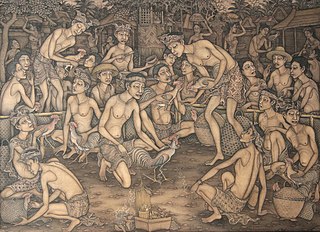
Balinese art is an art of Hindu-Javanese origin that grew from the work of artisans of the Majapahit Kingdom, with their expansion to Bali in the late 14th century. From the sixteenth until the twentieth centuries, the village of Kamasan, Klungkung, was the centre of classical Balinese art. During the first part of the twentieth century, new varieties of Balinese art developed. Since the late twentieth century, Ubud and its neighboring villages established a reputation as the center of Balinese art.

The Refaluwasch people are a Micronesian ethnic group who originated in Oceania, in the Caroline Islands, with a total population of over 8,500 people in the Northern Mariana Islands. They are also known as Remathau in the Yap's outer islands. The Carolinian word means "People of the Deep Sea." It is thought that their ancestors may have originally immigrated from Asia and Melanesia to Micronesia around 2,000 years ago. Their primary language is Carolinian, called Refaluwasch by native speakers, which has a total of about 5,700 speakers. The Refaluwasch have a matriarchal society in which respect is a very important factor in their daily lives, especially toward the matriarchs. Most Refaluwasch are of the Roman Catholic faith.

A Pura is a Balinese Hindu temple and the place of worship for adherents of Balinese Hinduism in Indonesia. Puras are built following rules, style, guidance, and rituals found in Balinese architecture. Most puras are found on the island of Bali, where Hinduism is the predominant religion; however many puras exist in other parts of Indonesia where significant numbers of Balinese people reside. Mother Temple of Besakih is the most important, largest, and holiest temple in Bali. Many Puras have been built in Bali, leading it to be titled "the Island of a Thousand Puras".

Canggu is a coastal village with a 10 km-long beach on the south-west coast of Bali, Indonesia.
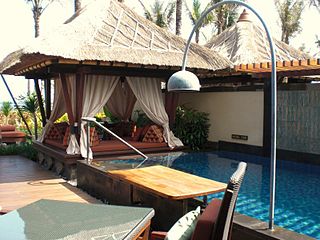
Balinese architecture is a vernacular architecture tradition of Balinese people that inhabits the volcanic island of Bali, Indonesia. Balinese architecture is a centuries-old architectural tradition influenced by Balinese culture developed from Hindu influences through ancient Javanese intermediary, as well as pre-Hindu elements of native Balinese architecture.

DFS Group (DFS) is a Hong Kong-based travel retailer of luxury products. Established in 1960, its network located in major airports and downtown stores around the world, including duty-free stores in 12 airports and 21 downtown locations, as well as affiliate and resort locations, featuring 750 brands. It is privately held and majority owned by the luxury conglomerate Moët Hennessy Louis Vuitton (LVMH), alongside DFS co-founder and shareholder Robert Warren Miller. As of January 11, 1997, DFS Group operates as a subsidiary of LVMH.
Maximilian Jencquel is a Venezuelan-born, German and French designer. His notable projects include his private residences in Ubud, Bali, Indonesia.